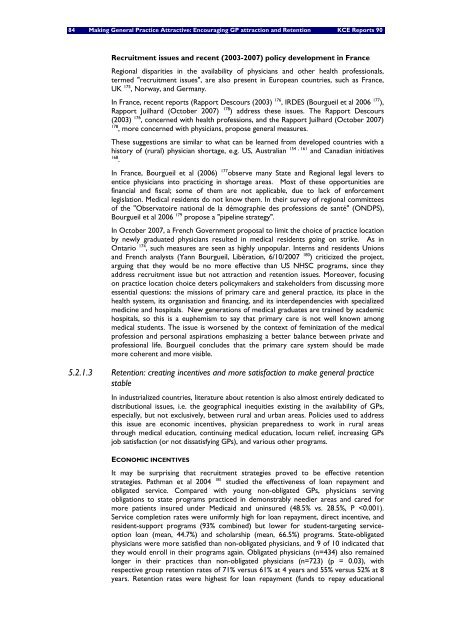Download the report (150 p.) - KCE
Download the report (150 p.) - KCE
Download the report (150 p.) - KCE
Create successful ePaper yourself
Turn your PDF publications into a flip-book with our unique Google optimized e-Paper software.
84 Making General Practice Attractive: Encouraging GP attraction and Retention <strong>KCE</strong> Reports 90<br />
Recruitment issues and recent (2003-2007) policy development in France<br />
Regional disparities in <strong>the</strong> availability of physicians and o<strong>the</strong>r health professionals,<br />
termed "recruitment issues", are also present in European countries, such as France,<br />
UK 175 , Norway, and Germany.<br />
In France, recent <strong>report</strong>s (Rapport Descours (2003) 176 , IRDES (Bourgueil et al 2006 177 ),<br />
Rapport Juilhard (October 2007) 178 ) address <strong>the</strong>se issues. The Rapport Descours<br />
(2003) 176 , concerned with health professions, and <strong>the</strong> Rapport Juilhard (October 2007)<br />
178 , more concerned with physicians, propose general measures.<br />
These suggestions are similar to what can be learned from developed countries with a<br />
history of (rural) physician shortage, e.g. US, Australian 154 , 161 and Canadian initiatives<br />
168 .<br />
In France, Bourgueil et al (2006) 177 observe many State and Regional legal levers to<br />
entice physicians into practicing in shortage areas. Most of <strong>the</strong>se opportunities are<br />
financial and fiscal; some of <strong>the</strong>m are not applicable, due to lack of enforcement<br />
legislation. Medical residents do not know <strong>the</strong>m. In <strong>the</strong>ir survey of regional committees<br />
of <strong>the</strong> "Observatoire national de la démographie des professions de santé" (ONDPS),<br />
Bourgueil et al 2006 179 propose a "pipeline strategy".<br />
In October 2007, a French Government proposal to limit <strong>the</strong> choice of practice location<br />
by newly graduated physicians resulted in medical residents going on strike. As in<br />
Ontario 174 , such measures are seen as highly unpopular. Interns and residents Unions<br />
and French analysts (Yann Bourgueil, Libération, 6/10/2007 180 ) criticized <strong>the</strong> project,<br />
arguing that <strong>the</strong>y would be no more effective than US NHSC programs, since <strong>the</strong>y<br />
address recruitment issue but not attraction and retention issues. Moreover, focusing<br />
on practice location choice deters policymakers and stakeholders from discussing more<br />
essential questions: <strong>the</strong> missions of primary care and general practice, its place in <strong>the</strong><br />
health system, its organisation and financing, and its interdependencies with specialized<br />
medicine and hospitals. New generations of medical graduates are trained by academic<br />
hospitals, so this is a euphemism to say that primary care is not well known among<br />
medical students. The issue is worsened by <strong>the</strong> context of feminization of <strong>the</strong> medical<br />
profession and personal aspirations emphasizing a better balance between private and<br />
professional life. Bourgueil concludes that <strong>the</strong> primary care system should be made<br />
more coherent and more visible.<br />
5.2.1.3 Retention: creating incentives and more satisfaction to make general practice<br />
stable<br />
In industrialized countries, literature about retention is also almost entirely dedicated to<br />
distributional issues, i.e. <strong>the</strong> geographical inequities existing in <strong>the</strong> availability of GPs,<br />
especially, but not exclusively, between rural and urban areas. Policies used to address<br />
this issue are economic incentives, physician preparedness to work in rural areas<br />
through medical education, continuing medical education, locum relief, increasing GPs<br />
job satisfaction (or not dissatisfying GPs), and various o<strong>the</strong>r programs.<br />
ECONOMIC INCENTIVES<br />
It may be surprising that recruitment strategies proved to be effective retention<br />
strategies. Pathman et al 2004 181 studied <strong>the</strong> effectiveness of loan repayment and<br />
obligated service. Compared with young non-obligated GPs, physicians serving<br />
obligations to state programs practiced in demonstrably needier areas and cared for<br />
more patients insured under Medicaid and uninsured (48.5% vs. 28.5%, P
















